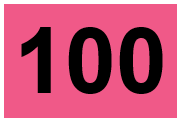City buses offer the cheapest and overall most convenient way to get around in Kyoto. A few lines specifically aim the needs of visitors who travel for the purpose of sightseeing. Among them are the three Raku lines.
In this page we briefly describe itineraries that require few transfers by means of Line 100. No other means of transport is required, though in many cases you may want to include a few walking tours.
⇒ Notice (August 2024)
Kyoto City Bus Linea 100 is currently out of service. Many other bus lines serve the same route; among those, of particular usefulness for visitors are Line 5, Line 86 and Line 206.
Kyoto City Bus Line 100: essential information

Line 100 is one of the three Raku Bus lines. These lines are aimed at satisfying the needs of travellers as they link many of Kyoto’s main sightseeing spots, attractions, landmarks and popular neighbourhoods.
The three Raku lines describe a circular path connecting three major places of interest:
-
Kyoto Station;
-
Ginkaku-Ji Temple;
-
Kinkaku-Ji Temple.
Regardless of how long your stay in Kyoto will be, you are likely to pass by all these places.
Line 100 serves the eastern part of the city, in particular the districts comprised between Kyoto Station and Ginkaku-Ji, major temple and landmark located in southern Sakyo.
Of particular interest is the central section, where Line 100 gets through southern Higashiyama and Gion. These are among the most interesting parts of the city to visit, an area dense with cultural heritage and fascinating architecture where you will enjoy walking, wandering, exploring and also getting lost.
The number of sightseeing places, especially the ones of cultural significance, that are served by Line 100 is so big that you may even spend 2 or 3 days by solely getting around on buses of this line.
If you travel under strict time constraints you will most likely choose to limit the scope of your programme and opt for a less intensive schedule.
In this page we outline a one-day and a two-day itineraries along Line 100. Both programmes are very suitable for short journeys (3-5-day itineraries).
Notable railway stations along the line
Beside Kyoto Station, the city’s main railway hub, linked to the national shinkansen (high-speed) railway network, Line 100 serves a number of minor railway stations of local lines. These can be of interest, especially to those who reach Kyoto from Osaka. One of these stations is Shichijo-Eki, served by the Keihan Main Line, a railway connection between Eastern Kyoto and Central Osaka.
Kyoto Bus Line 100: route
As anticipated, Line 100 serves a fundamental sightseeing route. Moreover, it connects two areas where first-time travellers often choose to find their lodgings, i.e., the surroundings of Kyoto Station and Gion (as well as nearby Kawaramachi, across the river).
We suggest you spend some time on a map and find reference points. Doing so will make things easier when you have reached Kyoto. Detailed material is available at the tourist office of Kyoto Station, really outstanding as for quality and variety.
In the following prospect we list the stops that can be useful for organising itineraries along Line 100.
Line Raku 100 (Kyoto-shi Basu)Relation: Kyoto Station - Ginkaku-Ji |
|
|
Bus stop |
Places of interest (distance, in metres) Interchange |
|
Kyoto-Eki-mae |
Kyoto Station (100 m) |
|
Nanajo Kawaramachi |
Shosei-En Gardens (500 m) |
|
Nanajo Keihan-mae |
Kamo River (100 m) Kiyamachi-dori street (300 m) Shosei-En Gardens (900 m)
Shichijo Station (Keihan Main Line) (150 m) Line 南5: for Fushimi Inari Taisha |
|
Hakubutsukan Sanjusangendo-mae |
Sanjusangen-Do (100 m) Kyoto National Museum (100 m) |
|
Higashiyama-Nanajo |
Southern Higashiyama Chishaku-In (200 m) |
|
Gojo-zaka |
Kiyomizu-dera (900 m) Sannen-zaka (600 m) |
|
Kiyomizu-michi |
Kiyomizu-dera (900 m) Sannen-zaka (500 m) Ninen-zaka (500 m) |
|
Gion |
Yasaka-Jinja (100 m) Maruyama Park (500 m) Chion-In (700 m)
Line 12: for Kinkaku-Ji Line 203: for Shinnyo-Do |
|
Higashiyama-Sanjo |
Shoren-In (700 m)
Higashiyama Station (Tozai Line, subway) (200 m) Line 5: for Eikan-Do and Nanzen-Ji |
|
Okazakikoen Bijutsukan / Heian-Jingu-mae |
Heian-Jingu (1.000 m) |
|
Okazakikoen Dobutsuen-mae |
Kyoto City Zoo |
|
Okazaki Michi |
|
|
Higashi Tennocho |
Nanzen-Ji (800 m) Eikan-Do (800 m)
Line 93: for Arashiyama |
|
Miyanomaecho |
|
|
Honenin-cho |
Honen-In (600 m) |
|
Ginkakuji-mae |
Ginkaku-Ji (500 m) Philosopher’s Path (200 m) |
|
Ginkakuji-michi |
Nomura Museum ( 200 m)
Line 102: for Kinkaku-Ji |
|
Kinrin Shako-mae |
|
|
Jingu Michi |
|
|
(*) Line 100 provides connection to a far larger number of lines. Here we have simply mentioned the lines that are typically used by tourists. |
|
Travel times
Travel duration, approximate, from Kyoto Station:
-
Kiyomizu-dera: 25 minutes (15 minutes by bus; 10 minutes on foot);
-
Gion (Yasaka-Jinja): 21 minutes (20 minutes by bus; 1 minute on foot);
-
Heian Shrine: 30 minutes (26 minutes by bus; 4 minutes on foot);
-
Ginkaku-Ji: 48 minutes (40 minutes by bus; 8 minutes on foot).
For each relation we have listed the minimum duration of the journey. Transfers may take more time in high season, during the cherry blossom or national holidays when traffic is a frequent occurrence.
Tariffs
Line 100 belongs to the Kyoto-Shi Basu network (the municipal network). Therefore tariffs are fixed and amount to 230 yen for an adult and 120 yen for a child (of 12 years of age or below).
Differently from ordinary bus lines, tariffs are collected when you get on the bus (through the front door near the driver).
If you plan on using the public transportation system many times, you may take advantage of the one-day pass, which costs 1.100 yen and allows for unlimited use of bus and subway lines.
Alternatives to Kyoto Bus Line 100
In high season buses of the Line 100 are often crowded. Delays are possible and the journey can become unpleasant.
Aside from opting for the taxi, you may resort to other alternative solutions:
-
Transfers by subway and by bus: if you wish to reach Ginkaku-Ji from Kyoto Station you may take the subway (Karasuma Line) up to Imadegawa Station. Here you can transfer to a bus of Line 102;
-
Staying in the city centre of Kamigyo: a good option is to stay in the city centre. Cheaper lodgings can be found in Kamigyo, a pleasant neighbourhood where you can see the ordinary non-touristy city. If you stay in Kamigyo you can get around by bicycle. Many traditional guest houses offer bicycle rentals at a cheap price. Make sure you book your hotel well in advance;
-
Re-organising the itinerary: another option is to organise transfers in a different way. The Keihan Main Line offers a convenient way to move between different locations in Higashiyama. The line runs parallel to Kamo River. If you do not mind some walking, getting around by train can be a good option to avoid crowded buses. This is particularly effective if you visit Kyoto with a day-excursion from Osaka. Stations along the southern part of Higashiyama are quite close to important sightseeing spots (the only exception being Kiyomizu-dera). Ginkaku-Ji can be reached from Demachiyanagi Station with a 20-30 minute walk.
Recommended itinerary along Line 100
We briefly outline a one-day and two-day itinerary along the bus Line 100. We assume you start your journey from Kyoto Station. It is very easy to arrange for itineraries with different starting points.
One-day itinerary
The following is the programme for a one-day itinerary through Higashiyama and southern Sakyo. It is most suitable for a three-day visit in Kyoto.
One day in Kyoto: itinerary along Line 100Relation: Kyoto Station - Ginkaku-Ji Temple |
|
|
Bus stop |
Sightseeing places |
|
Kyoto-Eki-mae |
Kyoto Station (100 m) |
|
Gojo-zaka |
Kiyomizu-dera (900 m) |
|
|
Walking tour; starting point: Kiyomizu-dera Destinations:
|
|
Gion |
Yasaka Shrine (100 m) |
|
Ginkakuji-mae |
Ginkaku-Ji (500 m) Philosopher’s Path (200 m) |
Related articles:
Main article: Kyoto 3-day itinerary
Itineraries along the Keihan Main Line: Southern Higashiyama | Northern Higashiyama and Sakyo

